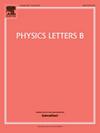更新了确定Ellis-Jaffe和规则直至N3LO QCD修正
IF 4.5
2区 物理与天体物理
Q1 ASTRONOMY & ASTROPHYSICS
引用次数: 0
摘要
在本文中,我们探讨了Ellis-Jaffe和规则(EJSR)的性质,采用最大共形原则(PMC)方法来解决其微扰部分,直到次-次-次-次-先阶(N3LO) QCD贡献。通过应用PMC,我们实现了EJSR的精确微扰QCD预测,避免了与重归一化尺度选择相关的传统模糊性。考虑到渐近尺度附近αs朗道极的存在,我们引入了基于解析摄动理论(APT)的低能αs模型来改进红外区域的EJSR行为。通过将PMC方法与低能APT模型相结合,EJSR的理论计算与实验测量的一致性得到了显著提高,χ2/d.o.f|Conv =1.86与χ2/d.o.f|PMC=1.19之间的差异减小,从而验证了方法的有效性。本文章由计算机程序翻译,如有差异,请以英文原文为准。
Updated determination of Ellis-Jaffe sum rules up to N3LO QCD corrections
In this paper, we explore the properties of the Ellis-Jaffe Sum Rule (EJSR) by employing the Principle of Maximum Conformality (PMC) approach to address its perturbative part up to next-to-next-to-next-to-leading order () QCD contributions. By applying the PMC, we achieve a precise perturbative QCD prediction for the EJSR, free from conventional ambiguities associated with the renormalization scale choices. Considering the presence of the Landau pole near the asymptotic scale, we incorporate the low-energy model based on analytic perturbation theory (APT) to refine the EJSR behavior in the infrared region. By combining the PMC approach with the low-energy APT model, the agreement between theoretical calculations and experimental measurements of EJSR is significantly improved, as evidenced by the reduced discrepancy from to , thereby validating the effectiveness of our approach.
求助全文
通过发布文献求助,成功后即可免费获取论文全文。
去求助
来源期刊

Physics Letters B
物理-物理:综合
CiteScore
9.10
自引率
6.80%
发文量
647
审稿时长
3 months
期刊介绍:
Physics Letters B ensures the rapid publication of important new results in particle physics, nuclear physics and cosmology. Specialized editors are responsible for contributions in experimental nuclear physics, theoretical nuclear physics, experimental high-energy physics, theoretical high-energy physics, and astrophysics.
 求助内容:
求助内容: 应助结果提醒方式:
应助结果提醒方式:


